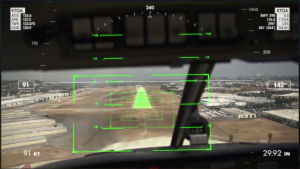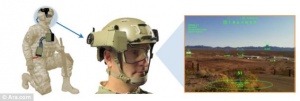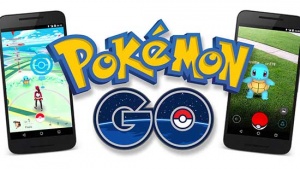Augmented Reality
Augmented Reality (AR) is the integration of artificial elements and a real-world environment in order to supplement perception in some way, facilitated through an electronic device. The goals of this technology are ultimately to transform the real world into an interactive environment, particularly through the computer vision-based overlay of digitally created visual artifacts, though auditory and tactile elements can be implemented. Unlike virtual reality, augmented reality is meant to support reality instead of recreating a new one for the agent. AR can be implemented in wearable technology, similar to the approach of the suspended Google Glass, but is now used in applications for smartphones, one example being PokémonGO. Uses across a number of industries, including aviation, design, medicine, education, gaming, and the military, have revolutionized the workplace and human lifestyle. The first augmented reality device was credited to Ivan Sutherland in 1968, with the namesake term being developed by Boeing in the 1990s. In 2016, the AR industry reached $1.1 billion in investments, and Microsoft Inc. released the HoloLens, a headset created to enhance daily life with the ability for developers to design their own apps for the system. Collectively, AR systems aim to integrate external information with that of reality to enhance the user's day-to-day operations.
Contents
Research and Development
Computer Vision and Software
Hardware
Augmented reality hardware largely consists of wearable technology. Often a headset with goggles is used to overlay the virtual elements onto the view of reality. In some cases, like Google Glass, the hardware is minimal, but in others, like Microsoft HoloLens, the hardware is more substantial.
More recently, smartphones, such as Apple's iPhone line or the various Android-supporting phones, can download AR-based applications. Developers can make use of the GPS and gyroscopic elements common in smartphone, as well as the wide variety of cameras.
Uses
Aviation and Military
One of the largest challenges for aviation professionals is accurately and safely navigating an aircraft. Today, many aerospace companies utilize augmented reality simulations in training their pilots. Additionally, the company AeroGlass has developed an augmented reality system for commercial and private aviation pilots. By superimposing relevant details using the goggle-like hardware over the view from the cockpit, they aim to make aviation safer and more stable. Similarly, the United States military has rolled out AR reality helmets that supports their pilot's views during flight in high speed aircraft. NASA has also used AR in their flight technology during the tenure of the Space Shuttle.
The United States ground forces also employ augmented reality helmets called ARC4 that allow them to see maps and more easily communicate with their counterparts on the ground. Developed by ARA, the goal was to allow for better coordination of ground forces during active duty. By integrating day-time and night-time vision technology, the display provides real time information about the mission, the location of forces, and potential threats nearby. Also, for training purposes the military employs Augmented Immersive Team Training, a program designed to get soldiers out of simulators and into the field. This type of technology can better prepare troops for combat missions and ultimately protect their lives in the face of danger.
Education
AR's role in education is still being explored, but currently there are many applications that integrate augmented reality into education and the classroom. Research into how AR can be used to treat attention disorders such as ADHD and how it can be used to cater to differing learning styles in classrooms has been promising.
Google Tango is being integrated into museums, such as the Detroit Institute of Art, where visitors can rent out Tango supported phones and explore the exhibits through a new lens. For instance, viewing a mummy from above using the Tango application can show an X-ray image of the skeleton below the surface of the sarcophagus. There are also applications available to create augmented reality-based works of art, which can be utilized in art classes.
Medicine
Design
Augmented reality applications have increased in popularity in the design industry. There are numerous applications in both the Apple App Store and Google Play, the Android Application Shop, for design-centered augmented reality. in 2013, IKEA released an application allowing users to place virtual furniture in their homes using their smartphone's camera. This gives customers the opportunity to visualize how their spaces will look before buying goods from IKEA in real time. Google Tango expands on this idea, giving users the chance to virtually transform their spaces with furniture and appliances. With Tango, developers can create their own applications for design-related purposes for personal and business use.
Video Games
Smartphones now make augmented reality gaming far more accessible and can be tailored to individual needs.
Of the most recent AR games and applications, PokémonGO, developed by Niantic Labs, is of the most popular. As in Nintendo's Pokémon series, the game focuses on catching virtual creatures named Pokémon, which then are able to train and battle those of others'. Released on July 6, 2016, the game skyrocketed to the top of the Apple App Store and Google Play charts and sparked a social interaction across the world around this common interest. While the game is not strictly based in AR, when catching different Pokémon, the user has the option to overlay the creature onto the image created using the smartphone's camera to make it seem like the Pokémon is actually right in front of you when you go to catch it using the game's PokéBalls.
Other popular games include Niantic's Ingress. Microsoft's Occulus Rift also supports gaming, and as of late 2016, Xbox One games can be viewed through the Occulus Rift during gameplay.
Past and Present AR Devices
Google Glass
HoloLens
Ethical Issues
The ethics behind augmented reality is largely an unexplored. Very little policy has been written to protect users from the dangerous AR presents, and virtually no existing policy has been updated to include AR technologies. As the product is mostly up to the developer, many concerns need to be addressed.


